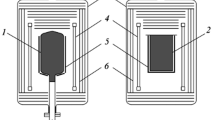Conclusions
From finely milled fused quartz it is possible to obtain, by the slip method, adequately strong quartz products with high thermal-shock resistance at low firing temperatures. A substantial increase in the strength of the quartz products can be obtained by impregnating them with silicone resins followed by firing at 1100°C.
Similar content being viewed by others
Literature cited
J. D. Walton, Ceramic Age, No. 2, p. 23–25 (1960).
J. D. Walton, Ceramic Age, No. 3, p. 33–38 (1960).
J. D. Walton, Ceramic Age, No. 5, p. 52–58 (1961).
J. Fleming, J. Amer. Ceramic, Soc., Vol.44, No. 12, p. 748–750 (1961).
W. Schulle, Silikattechnik, Bd. 13, No. 7, p.229–232 (1962).
W. Schulle, Silikattechnik, Bd. 13, No. 8, p. 282–284 (1962).
Chase Vance, J. Ceram. Ind, Vol.83, No. 3, p. 91–95, 98, 115 (1964).
Author information
Authors and Affiliations
Additional information
Translated from Ogneupory, No.1, pp.47–49, January, 1967.
Rights and permissions
About this article
Cite this article
Voronin, N.I., Churakova, R.S. Quartz products made by slip casting. Refractories 8, 50–52 (1967). https://doi.org/10.1007/BF01290210
Issue Date:
DOI: https://doi.org/10.1007/BF01290210




